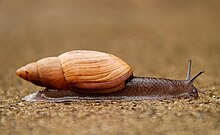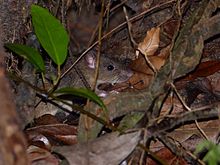
The snail extinction prevention program (SEPP) or Hawaii snail extinction program, is a program founded in 2012 and currently directed by David Sischo that is trying to prevent the extinction of Hawaii's many rare snails such as Achatinella and snails of the family Amastridae.

Actions taken
Snail enclosures

One of the ways the SEPP tries to save those rare snails is by keeping them in an fenced and constantly monitored enclosure in the Hawaiian forest that keeps them away from invasive snails, such as the Rosy Wolfsnail and other introduced predators, such as the Jackson's chameleon, the land flatworm Platydemus manokwari, and black rats.
Enclosure walls

The walls of the SEPP snail enclosures includes a smooth lined wall to prevent chameleons,a steel fence, protected with a rim to ensure wolfsnails do not climb over the fence. Behind the steel fence, there are electric wires to prevent any wolfsnails that do get in from swallowing the native snails whole.
Lab snails

The SEPP also keeps snails in a laboratory in, Kawainui Marsh, Oahu, Hawaii.
Evacuation
In 2018 Hurricane Lane approached the lab and the snails that lived in the lab had to be evacuated. There are ongoing concerns about future evacuation problems since as of 2022 there are over five thousand snails living in the lab, while there were fewer snails living in the lab in 2020.
Achatinella pupukanioe

In 2015, the SEPP team found a tree full of Achatinella pupukanioe, a species thought to be extinct since the 1980s. The SEPP decided to leave them alone, but later when they went to collect the snails for the lab they were gone, possibly swallowed whole by rosy wolfsnails.
See also
References
- ^ Dooren, Thom van (2022). A World In A shell snail stories for a time of extinctions. MIT press. ISBN 9780262547345.
{{cite book}}: CS1 maint: date and year (link) - ^ Markovics, Joyce L. (2023). Yellow-tipped Oahu tree snail. Endlings. The last species. Ann Arbor, Michigan: Cherry Lake Publishing. ISBN 978-1-6689-0972-0.
- ^ "Snail Extinction Prevention Program". dlnr.hawaii.gov. (official web page for Snail Extinction Prevention Program)
- "David Sischo". researchgate.net.
- ^ "Achatinella Swainson, 1828". www.gbif.org. Retrieved December 13, 2024.
- "Biodiversity and Extinction of Hawaiian land snails:how many are left now and what we must do to save them". academic.oup.com. doi:10.1093/icb/icy043. Retrieved December 9, 2024.
- Van Dooren, Thom; Chrulew, Matthew, eds. (2022). Kin: thinking with Deborah Bird Rose. Durham: Duke University Press. ISBN 978-1-4780-2266-4.
- Bezan, Sarah; McKay, Robert, eds. (2022). Animal remains. Perspectives on the non-human in literature and culture. London New York: Routledge. ISBN 978-1-000-50648-8.
- ^ "Meet Hawaii's 'jewels of the forest'-some of the rarest animals on earth". npr.org. 2024.
- ^ "“Operation Snail Bail” Protects Tiny Native Creatures | Maui Now". | “Operation Snail Bail” Protects Tiny Native Creatures. Retrieved January 5, 2025.
- "pupu kani oe (Achatinella pupukanioe)". iNaturalist. Retrieved December 22, 2024.
- "NatureServe Explorer 2.0". explorer.natureserve.org. Retrieved December 26, 2024.